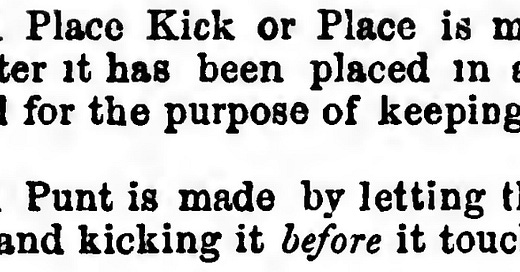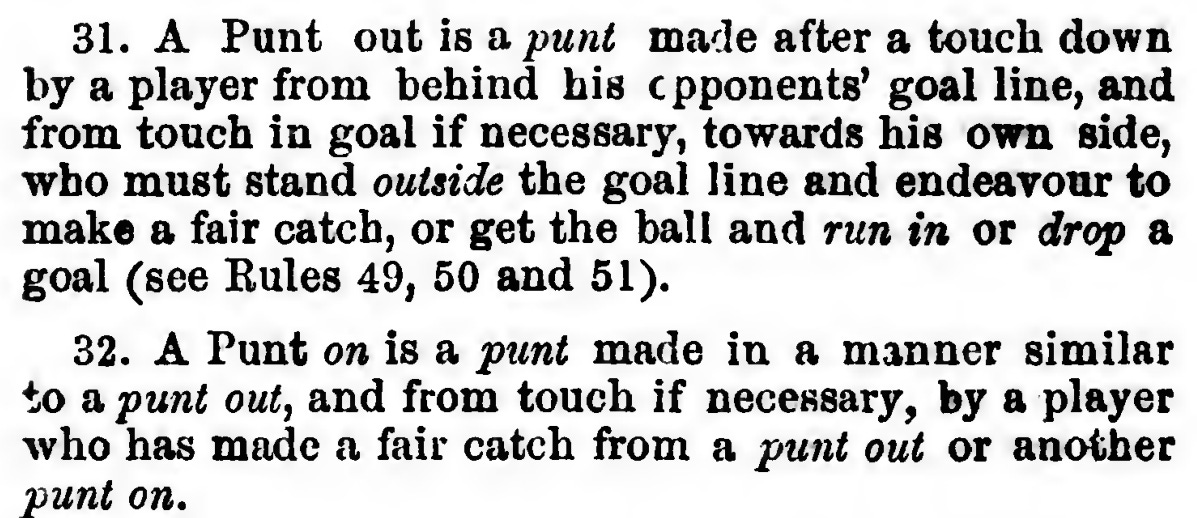The 1880 Rugby Rules
In the absence of a good source for pre-1880 American football rules, I’ve found this scanned rugby rulebook from 1882. The title notes that these were the rules adopted for rugby in Canada in 1880. I’d say that it’s safe to assume that these rules were very similar to the rules by which American football was played before 1880 — with the obvious exception of games that were played under association football rules (which is a topic for another post).
Instead of posting the entire book, I’ll point out a few sections that should be familiar to you:
Punts and place kicks have not changed from their rugby origins. Drop kicks are also a thing in modern American and Canadian football, though they are extremely rare. Well, unless you’re Doug Flutie, that is:
Interestingly enough, the rules for scoring goals (now a “field goal” or an “extra point”) have not changed since those days. The posts and the crossbar remain the same after all these years.
Of course, in rugby in those days, goals were the only way to score points. This is before Walter Camp created his scoring system, and before rugby union adopted a modified scoring system in 1886.
This is the old “safety as a tiebreaker” rule that was also common in the very early days of American football.
The “touchdown” was also a thing in rugby in those days, though it was not a goal according to the older rugby rules. It was called a “touchdown” because the player literally had to touch the ball down to the ground. This is still the case in modern rugby, though American and Canadian football are different.
A touchdown simply gave the team a chance to score a goal:
Note that the ball was brought “up to the goal line in a straight line from and opposite to the spot where the ball was touched down.” This becomes important when we start reading accounts of famous football games from the late 19th century. Teams frequently missed what became known as the conversion because the angle was impossible.
This is the old concept of “scrimmage,” which rugby fans recognize as a “scrum.” This was replaced by Walter Camp with a more organized system involving the two teams lining up facing each other.
This is the original offside rule. It makes sense from the standpoint of rugby — and certainly must have become complicated once scrimmage turned into a regular and formalized event. I’m not sure if the offside rule changed in 1880; if it didn’t, this would insinuate that defensive players would be offside as soon as the offense moved past them.
These two rules are obvious to anybody who has watched rugby. “Throwing back” is the modern lateral pass — and, of course, the forward pass was legalized formally in 1905.
The fair catch rule also dates back to the old rugby game.
I suppose you can see the origins of punting in these two somewhat confusing rules. The “punt out” was still a strategic move in 1894, if not later. This was because of the rule that a conversion had to take place parallel to the spot where the ball crossed the goalline; the “punt out” was the method by which the team that scored could center the ball again.
Kickoffs in early American football went backwards, much like a soccer kickoff. It seems that this was also the case in rugby, since the rules don’t specify which direction the kickoff should go.
These two rules are where we get the infamous fair catch kick, which is a play more rare than anything but the drop kick we saw above.
That gives you a really basic understanding of how football was played before 1880. As we start looking through old games, I’ll point out terminology and rules that will help explain old game accounts.
Note, by the way, that these old rugby rules say nothing about “interference,” which was illegal in rugby. “Interference” turned into “blocking” in the American and Canadian games, and is one of the hallmark features that sets the sports apart.



















